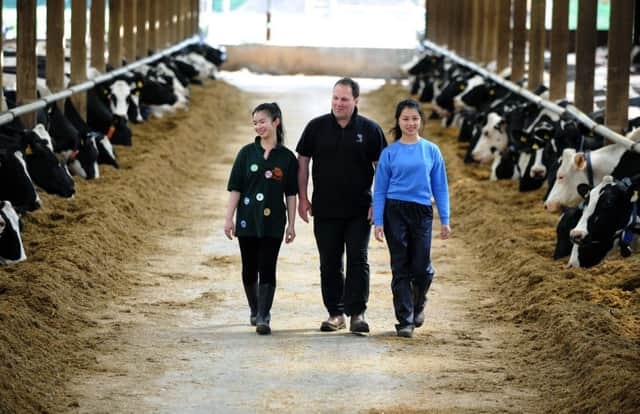Taking the bull by the horns in the dairy price battle


He and his son Chris are finding ways of coping with the fluctuations of milk price at Geoff’s farm in Brompton, near Northallerton.
Rather than rein in on production or stick with the same quantity while the price is low, at Lowfields production has increased. Geoff is keeping even more cows than two years ago and nearly double those he had five years back. He now has 600 Holstein milking cows and another 600 heifers for replacements and to sell to other dairy farmers.
Advertisement
Hide AdAdvertisement
Hide Ad“Some people reduce milk production to try and cut costs but we’re breeding cows that will give more milk.
“Our herd average is just below 12,000 kgs at the moment but we’re looking at that average moving up to 13,000 and we have some cows that give over 15,000 per year,” says Geoff.
Increasing production when the market price is low seems at odds with the thinking of other farmers but Geoff makes a convincing argument, even if the reason for a low milk price is largely blamed on over-production.
He makes more milk and Arla pays him at the same amount as his contracted volume, with no penalty for a degree of over-production if he manages it correctly, and that means he makes up for a little of the fall in milk price with larger supply.
Advertisement
Hide AdAdvertisement
Hide Ad“I know it seems to be totally against what is wanted but at the end of the day you have your fixed costs and investments and you have to bring in your income where you can. We’re on a milk contract with Arla and although some farmers generally receive a lower price for what is produced above a contracted volume, if we work it right then we can get the base market price set by Arla for what we supply in addition.
“So although we are currently getting 24.8 pence per litre, down from 33.8ppl this time last year, we are producing more than we were in an effort to make up that deficit.”
Milk is a commodity that fluctuates in production at certain times of the year and yet there is largely a steady demand throughout. This is why dairy companies, who buy milk from farmers, look for a ‘level profile’ – farms that produce a healthy supply each month.
Arla Amba, one of Europe’s largest dairy farmer co-operatives with 13,000 dairy farmer members, including 3,000 in the UK – and part of Arla – bases its contracts with dairy farmers on their milk production over the period from September to November; months when cows are less likely to produce the quantity of milk that they do between March and July, but representative of the demand for their products over the year.
Advertisement
Hide AdAdvertisement
Hide Ad“Usually in the autumn it’s more of a challenge to get cows to milk as well as they do in summer because of darker nights. You also get other things that affect cows.
“It’s important for our production to be as strong as it can be from September to November to set our own production level for the year ahead.
“And on top of that Arla allow for a dairy farm expansion of 10 per cent the following year, so we apply for that in addition. That gives us flexibility and an opportunity to make up some of the lost revenue of the market price.”
Dairy companies also need consistency of product and need the milk they receive to hit the parameters that suit their products. This means that dairy farmers need to achieve an agreed percentage of butterfat and protein content in their milk. It’s all part of the overall equation that determines the price paid.
Advertisement
Hide AdAdvertisement
Hide AdGeoff believes that the current formulas and methods that Arla and the Arla Amba have adopted are the right way to head for the future of the industry. He’s not one to bemoan the people he’s selling his milk to.
“I’m actually relieved we’re with Arla and that we’re a full member of the co-operative. They pay the full market price they can achieve each day and are pushing brands and new products.”
It is all a million miles away from when Geoff’s granddad George first purchased Lowfields in 1957 and had 25 cows. Today it’s three times a day milking and all the cows are kept housed on the 250-acre farm that grows 90 acres of wheat, 40 acres of spring barley and the rest down to grass.
“I never wanted three times a day milking but we’ve had a lift of between 12-15 per cent in production and you can’t argue with that. Our cows are in great condition too.”
Advertisement
Hide AdAdvertisement
Hide AdHong Kong veterinary students Alicia Ng and Letitia Pang have been staying with Geoff as part of their year-long studies in Edinburgh and they have been extremely impressed by Geoff’s attitude and his livestock.
“The cow welfare here is excellent. During our lectures this is always emphasised and our own feeling is that Geoff’s cow welfare here is even better than at our teaching farm.
“They’re all so clean and calm and allowed to do their own thing. He’s so passionate about them and has been the perfect host.”